NASCAR SimRacing Updated Hands-On
We take a look at the stock-car sim's career mode in our latest hands-on preview.
Since the death of development studio Papyrus, the PC stock-car racing scene has shifted toward a more arcade-style approach to the sport. Indeed, because the most recent PC NASCAR games published by EA (which owns exclusive rights to the series) have been upgraded ports of the company's popular console titles, there hasn't been a game that was designed with the avid PC racing community in mind in a while. Enter EA's latest oval-racing effort, NASCAR SimRacing, a PC-only title that seeks to fill that sim-shaped hole in the PC stock-car racing market.
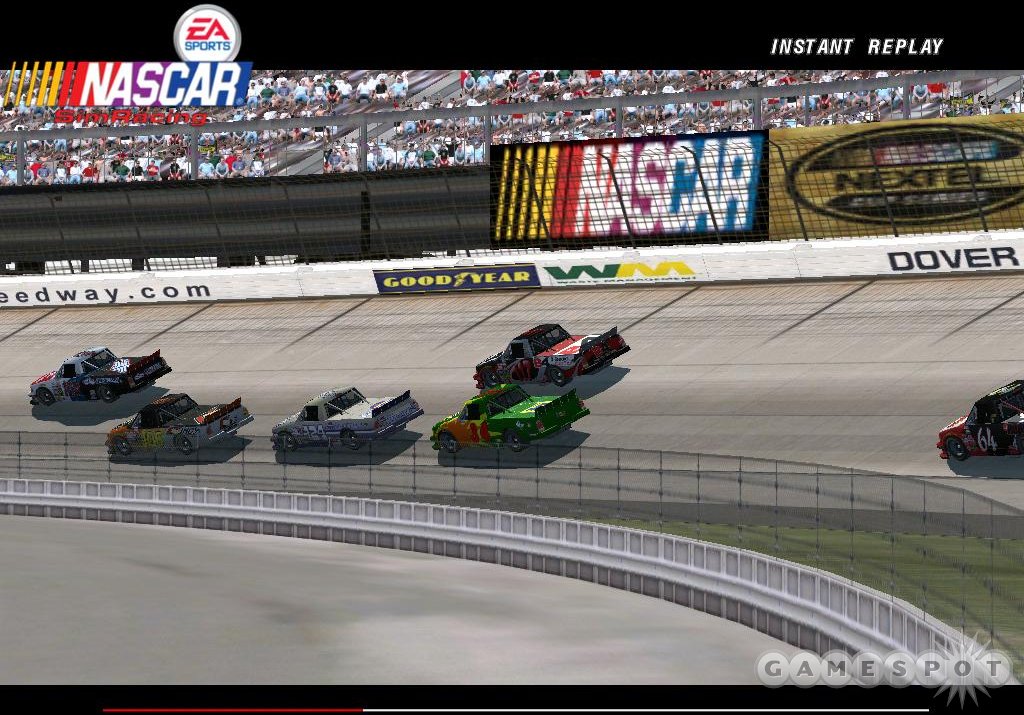
It's been nearly a month since we last sat down with NASCAR SimRacing. The first area we wanted to explore in our time with the latest version of the game was the career mode. Unlike the story-driven career mode found in last year's console NASCAR title, NASCAR 2005: Chase for the Cup, your career in SimRacing is thankfully free of melodramatic cutscenes and street races in Dodge Vipers. Instead, you'll be much more concerned with the only commodity more precious than speed in stock-car racing: money. While three NASCAR racing series are available in SimRacing's career mode--the Craftsman Truck Series, the National Series, and the Nextel Cup--you'll begin your career in the Truck Series, with a bare-bones vehicle you can repaint and rename as you see fit, and a team budget of around $1 million. And while that sounds like a lot of money, your expenses will quickly make it seem like chump change, especially if you aren't placing well in your races.
The two main departments begging for a slice of your budgetary pie include research and development and merchandising. With R&D you'll be investigating potential upgrades for your stock car (or truck) in areas such as power, torque, grip, and acceleration. Upgrades become more expensive the further into an attribute you progress, so a level-one power upgrade might run you only $30,000, while a level-four upgrade might cost many times more than that. In addition, all this research takes time to complete, measured in race events. The quicker the turnaround time for an upgrade, the more money it will cost you. If you're desperate for that level-three power upgrade in time for the Talladega race, for example, you'll need to ensure you either schedule enough time for a regular research cycle to complete, or prepare to have a much lighter wallet due to an expedited schedule. Also, to put your team's newfound upgrade knowledge to work, you'll need to construct a new car that will take advantage of the upgraded attributes discovered by the braniacs in your team's garage. As you might expect, a new car means more money out of your pocket. Finally, the R&D area will be where you repair any damage incurred by your car during the previous race weekend. Fail to repair your car to minimum specifications and you won't be eligible for the following week's race.
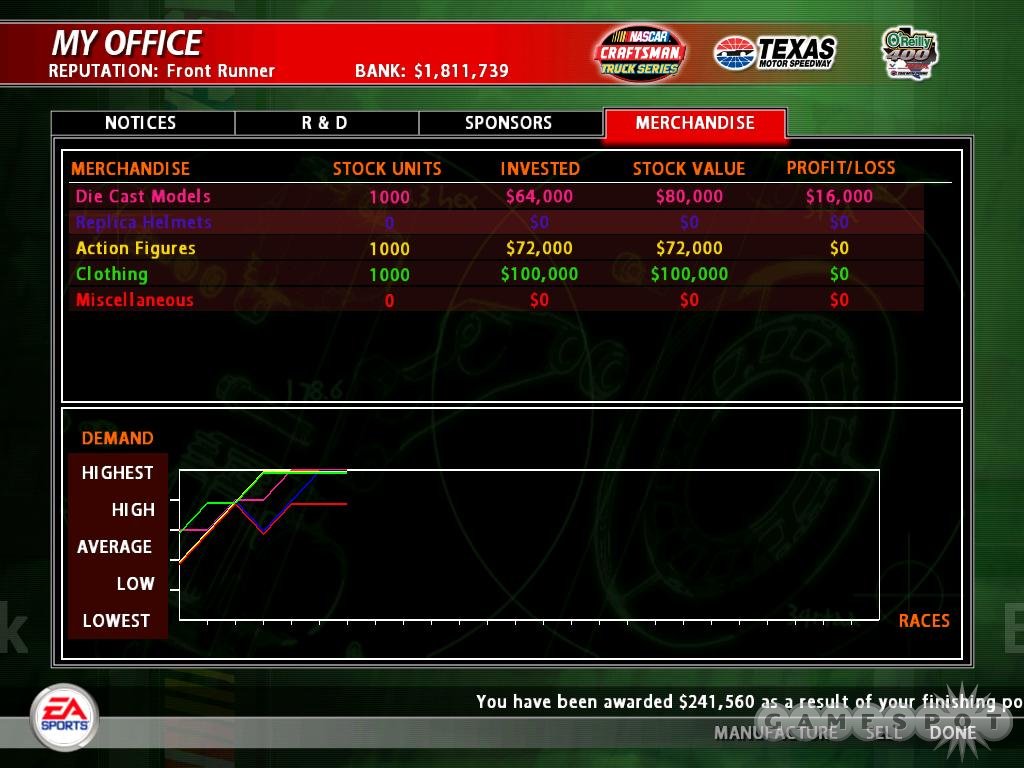
Merchandising is a double-edged sword, financially. NASCAR SimRacing allows you to create a number of different racing knickknacks that NASCAR fans love to purchase. These items include die-cast models, action figures, a line of clothing, and replica helmets, among other things. Each newly introduced line of merchandise requires an initial investment on your part to cover production costs. The good news is that the merchandise area features a "demand" graph that will keep track of fan demand for any of the products you can manufacture, making it simple to see where your money would be best spent. The bad news? Fan demand for your goods is tied to your performance on the track. Have a few bad finishes--or, worse, fail to finish a few events at all--and your merchandising ledgers might quickly go from black to red.
Advertising blitz!
Fortunately, race wins and bobbleheads won't be your only source of income. In true NASCAR fashion, every square inch of bodywork on your stock car is available for advertising. Let a corporation slap a logo for Kroger grocery stores or Sunoco fuel on your ride and watch the dollars roll in. Because your car can entertain only so many major sponsorships, and each sponsorship contract spans a certain number of races, you'll need to carefully weigh the pros (cash) and cons (contract length) of each deal before signing. You won't want to necessarily commit to that 12-race $23,000 Waste Management sponsorship early in the season, especially when you consider that much more lucrative offers will come your way after a few hard-earned race wins.
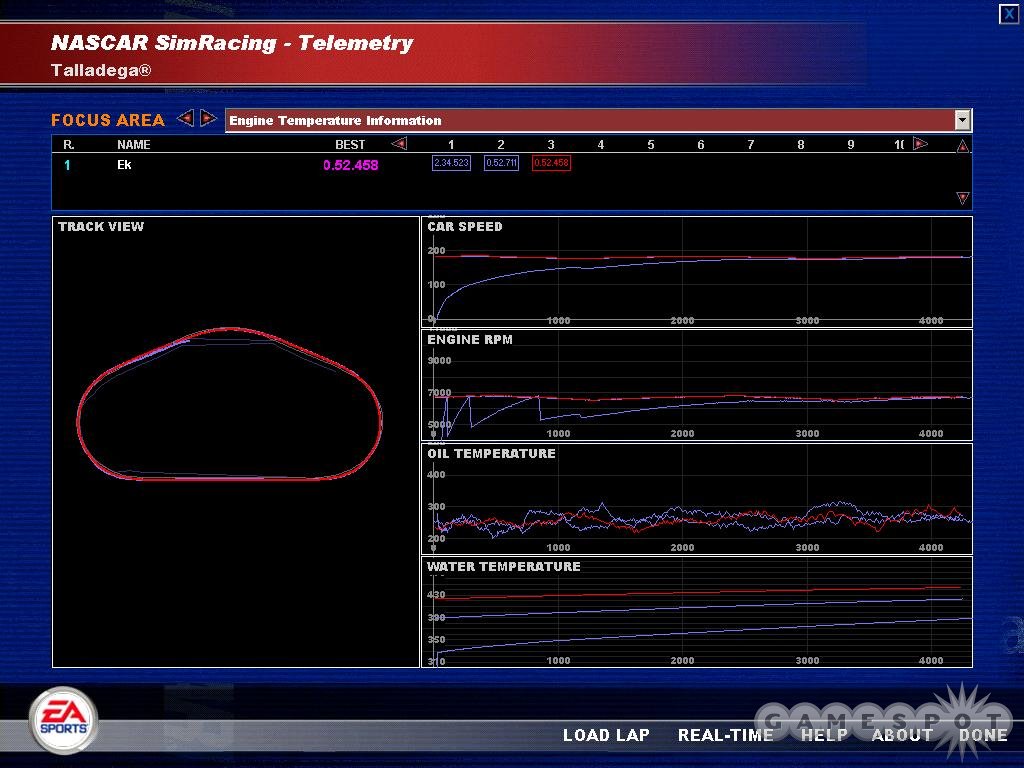
While NASCAR SimRacing is aimed at the experienced PC racing crowd, it's nice to see that the game doesn't shun less-experienced oval racers. In fact, along with a number of distinct difficulty settings, from beginner to veteran, you'll be able to independently adjust factors such as AI driver ability to customize the game to suit your skill level. This is a crucial feature, mainly because the leap in complexity between levels, especially among the top three, can be fairly severe. As you might expect, racing at Daytona Motor Speedway on beginner difficulty is so easy you'll feel like the only car on the track without a restrictor plate. Bump up the AI settings to intermediate, however, and the playing field will level out dramatically, leaving you to rely more on your skills as a driver than on any artificial advantage.
In our last preview of the game, we mentioned the in-depth telemetry options available to you during practice, qualifying, and race sessions. We said it once but it bears repeating: NASCAR SimRacing has some of the most detailed and accessible telemetry options ever found in a PC racing title. Not only is there a massive amount of car data--including engine and gearbox data, engine temperature readings, and driver input data (for braking, throttle, and clutch use)--but the information is also organized to make it easy to compare this information across multiple laps. Using a zoomable onscreen track map, you can even bore down to specific sections of the course to focus on information from only that sector of asphalt.
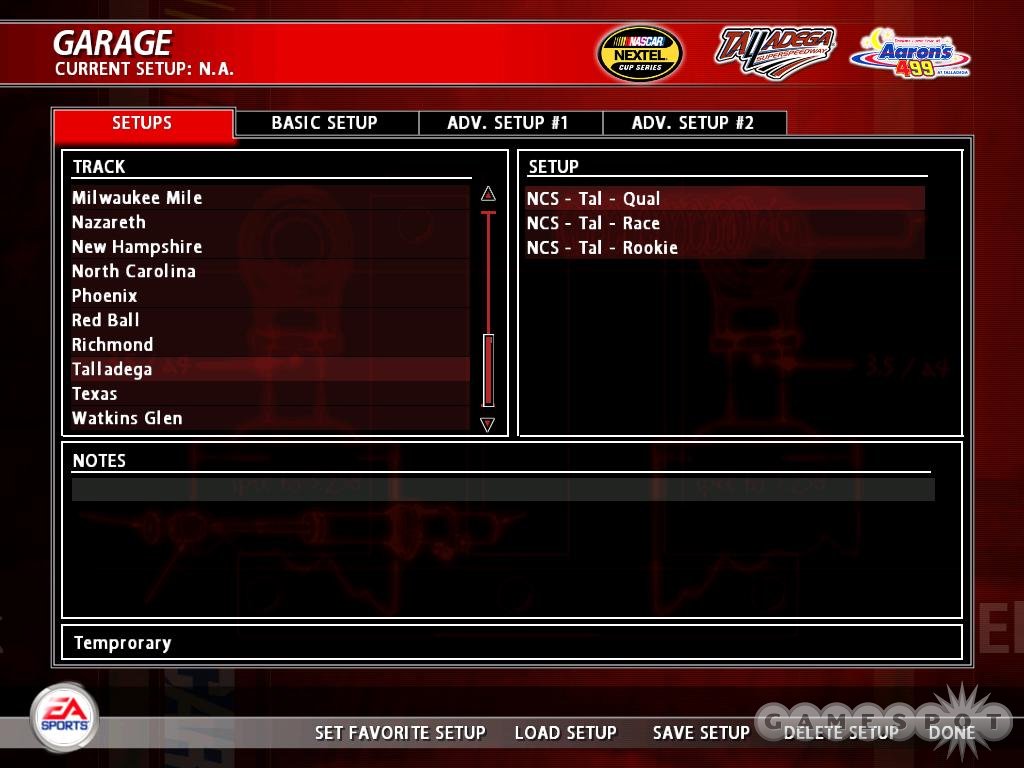
All the information gathered by the data-collection features is invaluable when you're choosing between the many car setup options found in the game. For the advanced crowd, seemingly every adjustable part found on an actual Nextel Cup stock car can be individually tweaked in the game, including gear ratios, grille tape, spoilers, brake bias, tire pressure, springs, and camber, all accessed through the game's two pages of advanced setup options. In another nod to less-experienced racers, the game will also feature a page for basic setup options, which simplifies the complex array of individual aspects in the more-advanced setups into three basic attributes: speed, handling, and response. For a car with more top-end speed, simply move the speed bar to the left. For more grip and acceleration (when racing short tracks such as Martinsville), move the bar to the right. You'll also be able to quickly and easily set the car up for more oversteer or understeer, as well as choose between a soft or stiff feel.
All these setup options have clear consequences for your performance on track, so, for those of us not intimately familiar with the give-and-take compromises inherent to high-performance auto tuning, each track in the game includes three preexisting setups you can apply to your ride right out of the gate. These setups consist of a low-fuel qualifying configuration (obviously used during the two-lap qualifying session before a race), a full race-spec setup for when it's time to hit the track, and a rookie setup for novice drivers. At the lower and intermediate difficulty levels, you'll find these setups will keep you competitive in nearly any race you run during the season.
Keeping it together on the track
When you're on the track, the feel of a NASCAR SimRacing stock car is tangibly different from that of its console counterparts. For one thing, the brakes on a Nextel Cup stock car are often optional, especially on superspeedways such as Las Vegas or Daytona. Instead, you'll adjust your speed by merely lifting off the gas as you wind your way through traffic and around corners. Short-track racing, on the other hand, requires an entirely different approach. Braking points on the shortest tracks in the game, such as the .375-mile Dodge Raceway, may be as early as the halfway point of a straightaway, which makes for some intense races, especially since you'll be completely surrounded by traffic for the duration of the race.
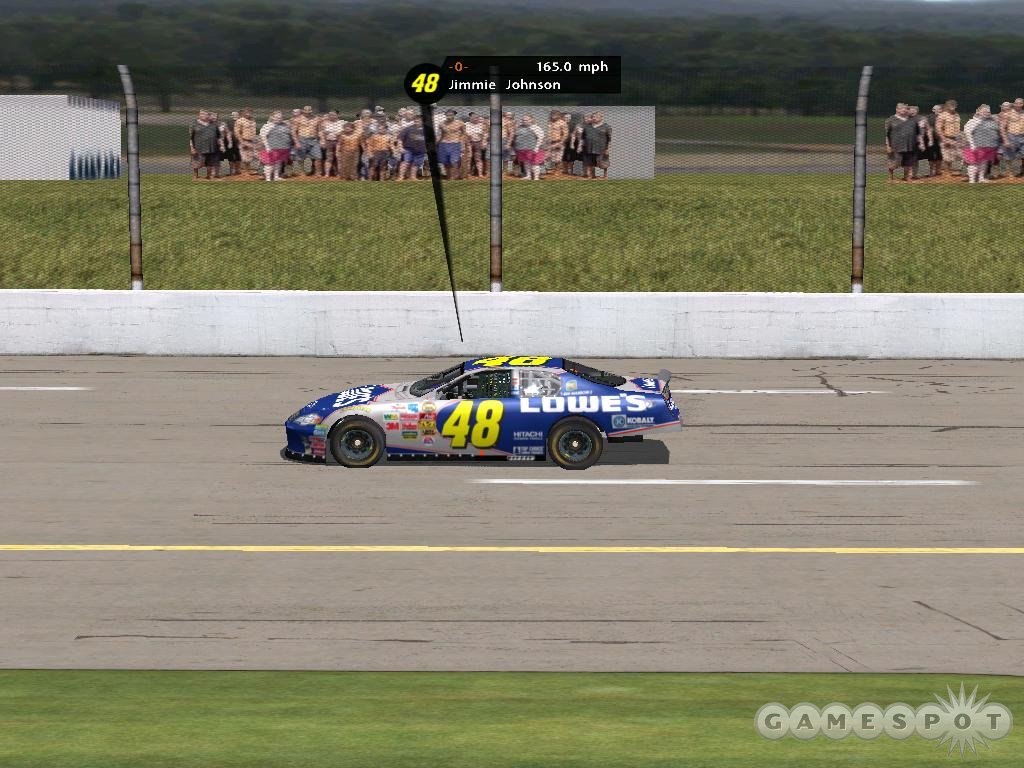
You'll not only be responsible for keeping your car out of harm's way in NASCAR SimRacing, but you'll also need to make sure you keep the car in good running order as a race progresses. For example, consistently pushing the engine will cause your water temperature to skyrocket, forcing you to either baby the engine until the end of the race, or dramatically alter your pit strategy (and possibly give up race position as a result). Tire conservation is another big concern, as high speeds and blistering track conditions can be murder on your tires.
Despite these potential pitfalls, you will have some audio and visual advantages on your side when playing the game. First and foremost is your spotter, who will be consistently feeding you information about your competitors' positions around your car, as well as important car data to keep in mind, such as the aforementioned water and engine temperatures, when pit windows open and close, and so on. At default audio settings, we found the roar of the engines, especially when surrounded by opponents, to be so loud as to drown out the voice of your spotter, but a few quick slider adjustments in the audio settings menu easily remedied that. The Dolby Pro Logic II-driven sound in the game is truly impressive, especially the deafening roar of the engines, which, as implied above, can make for an intimidating auditory experience when stuck in the middle of a pack.
For the more visually inclined, the game also features a host of icons that appear onscreen to indicate certain things, such as pit windows, drive-through penalties, and fuel level, as well as a number of official race indicator flags, including white (one lap remains in the race), green (drivers are cleared to race), and checkered (the leader has finished the race). While the interior cockpit view shows all the gauges on the dashboard of your car, you can also choose from several HUD options that present gauges such as the tachometer, oil pressure and temperature, water temperature, fuel pressure, and draft in a more easily viewable manner.

The development team has stated that the minimum specifications for NASCAR SimRacing will be a 1GHz Intel Pentium III or compatible processor, 256MB of RAM, and a 32MB Nvidia GeForce 2 card or ATI Radeon 7500 or better AGP video card. The recommended specs will be a 2GHz Intel Pentium 4 or compatible processor, 256MB of RAM, and an ATI Radeon 9000 or Nvidia GeForce FX or better. Racers with a high-speed Internet connection will able to take advantage of full-field races against up to 42 opponents on any of the authentic Nextel Cup tracks found in the game.
We're less than a month away from the Nextel Cup's "Super Bowl" race, the Daytona 500, which will be held on February 20. NASCAR SimRacing is due for release five days before that, just in time for the opening race. We'll bring you a full review of the game when it hits store shelves.
Got a news tip or want to contact us directly? Email news@gamespot.com
Join the conversation